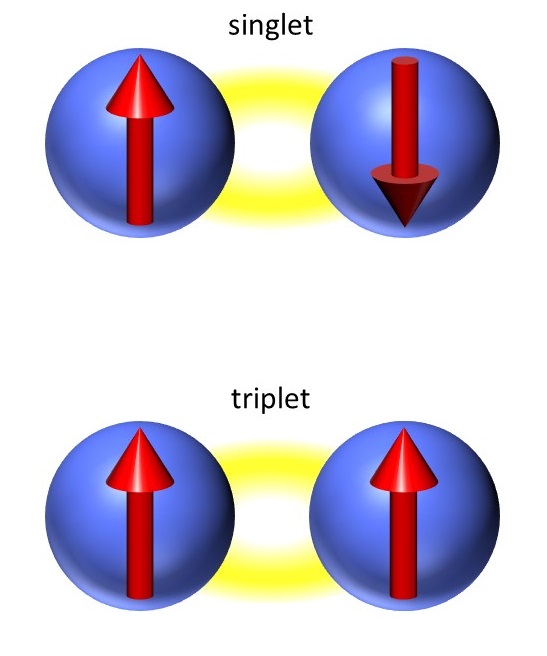Exotic Superconductivity: Tipping point for triplet pairing
This research article published in PNAS has been featured in Physics Today 74, 9, 14-16 (2021) and a press release of TU Wien (English version) as well as public broadcasting (ORF), Austria's leading newspapers (Wiener Zeitung) and other media.
Superconductivity remains one of the great mysteries of condensed-matter science. It is still not fully understood why certain materials lose their electrical resistance completely at low temperatures. While conventional superconductivity observed in pure elements and simple alloys is mediated by phonons, as described by the Nobel-Prize-winning BCS theory (named after Bardeen, Cooper and Schrieffer), the mechanism behind unconventional superconductivity remains an unsolved puzzle and is topic of ongoing research.
There is consensus, however, that electrons (fermions with charge e and spin S = 1/2) in a superconductor form Cooper pairs (bosons) that propagate through the material with zero resistance. While in a normal metal electric current consists of individual electrons that collide with each other and with the metal atoms, in a superconductor the electrons move in pairs. This can be considered similar to the difference between the intermittent walking through a crowd in a busy shopping street and the seemingly effortless motion of a dancing couple on the dance floor." When electrons are bound in Cooper pairs, they do not dissipate energy via scattering and move through the material without any disturbance.

Back in the 1990’s, a few years after the discovery of the cuprates, superconductivity was found in Sr2RuO4. This layered perovskite, which is isostructural to La2CuO4, exhibits metallic properties and superconductivity with Tc = 1.5 K in its pure form, i.e. without doping. Early on, it was suggested that the superconducting order parameter of Sr2RuO4 is a chiral triplet state, which would have made it a solid-state analogue to superfluid 3He-A phase. The triplet scenario was fueled by NMR Knight shift experiments in 1998 reporting the absence of a change in spin susceptibility across Tc, suggesting that the superconducting condensate is similarly polarizable by an external magnetic field like the normal-conducting electrons in the paramagnetic metallic state.
These exciting observations triggered hundreds of follow-up studies that aimed at a deeper understanding of the triplet state, resulting in many unexpected discoveries. Starting from 2018, we studied the uniaxial-strain response of Sr2RuO4 in Stuart Brown’s laboratory using NMR, in order to scrutinize the pronounced enhancement of Tc from 1.5 K up to 3.4 K upon uniaxial compression. While doing so, we observed a pronounced drop of Knight shift in the strained samples which, surprisingly, remained also at zero strain. Through thorough control experiments, we could reveal that the lack of a drop in spin susceptibility in the old study from 1998 was due to heating of the sample due to the NMR pulses. The measured temperature did not match the actual temperature of the sample studied; in fact, the sample studied at the time was not superconducting at all. The issue of pulse heating was subsequently confirmed by the authors of the initial study.
Our spectacular finding in 2019 that ruled out the chiral triplet state caused a stir in the field. After two decades of belief in the triplet scenario, the order parameter is an open question again. With these results in mind, the superconductivity of the material was now re-examined by NMR with great precision. By comparing the spin susceptibility with the field-dependent specific heat in the limit of T = 0, we could rule out a sizeable spin polarization of the superconducting condensate. Hence, the new results clearly show that Sr2RuO4 is not a triplet superconductor, but the spins rather pair up in an even parity (singlet) state. Overall, the thermodynamic and magnetic properties point towards a nodal d-wave scenario similar to the cuprates.
While the bubble of triplet superconductivity in Sr2RuO4 has burst, the new findings are by no means disappointing. It is a result that brings our understanding of high-temperature superconductivity in these materials another step forward. The similarities of strontium ruthenate and the cuprates suggest that their superconductivity has a similar origin. Certainly, ultra-pure Sr2RuO4 offers a much cleaner test field than cuprates where charge-carrier doping is indispensable for superconductivity, but also introduces disorder.
Beyond its scientific merits, of our work highlights the importance of cross-checking experimental results by different groups of the community. One might think that results in solid-state physics can hardly be wrong because we examine billions of billions (about 1019) electrons in a single crystal. But that does not mean that every measurement is completely correct. As everywhere in science, reproducing previous results is indispensable in our field - and so is falsifying them.
Original article:
A. Chronister*, A. Pustogow*, N. Kikugawa, D. A. Sokolov, F. Jerzembeck, C. W. Hicks, A. P. Mackenzie, E. D. Bauer and S. E. Brown
Proc. Natl. Acad. Sci. 118, e2025313118 (2021),
DOI:10.1073/pnas.2025313118, arXiv:2007.13730.
See also:
A. Pustogow*, Y. Luo*, A. Chronister, Y.-S. Su, D. A. Sokolov, F. Jerzembeck, A. P. Mackenzie, C. W. Hicks, N. Kikugawa, S. Raghu, E. D. Bauer, and S. E. Brown
Nature 574, 72–75 (2019),
DOI:10.1038/s41586-019-1596-2, arXiv:1904.00047.
See also:
Triplet no more, D. Abergel, Nat. Phys. 15, 1105 (2019)
Solving a Puzzle of Unconventional Superconductivity
Rewriting the story of unconventional superconductivity of Sr2RuO4: twenty year old result overturned

